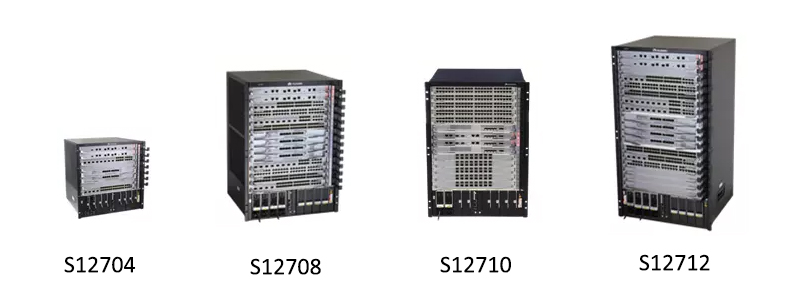
The Ethernet switches are one of the products which Huawei engineers are most familiar with. The complicated models, various specifications and similar names often confuse people.
Huawei switches consist of the S1700, S2700, S3700, S5700, S6700, S7700, S9700 and S12700 series.
Today, let’s make a comparison the S12700 series.
Overview of S12700 Series Switches
The S12700 series uses a Huawei Ethernet Network Processor (ENP) and provides a native Wireless Access Controller (AC) to help build a wired and wireless converged network. Its Unified User Management capabilities deliver unified user and service management, and Huawei’s Packet Conservation Algorithm for Internet (iPCA) supports hop-by-hop monitoring of any service
flows, helping manage services in a more refined way. The S12700 series runs the Huawei Versatile Routing Platform (VRP), which provides high-performance L2/L3 switching services and rich network services, such as Multiprotocol Label Switching (MPLS) VPN, hardware IPv6, desktop cloud, and video conferencing. In addition, the S12700 series offers a variety of reliability technologies, including non-stop forwarding, Cluster Switch System Generation2 (CSS2), a switch fabric hardware clustering system that allows 1+N backup of Main Processing Units (MPUs), hardware Eth-OAM/BFD, and ring network protection. These technologies help improve productivity and maximize network operation time, reducing Total Cost of Ownership (TCO).
The last two figures in the names of Huawei modular switches represent the number of service slots. For example, “S12712” represents that this model has 12 service slots. The following pictures shows the Huawei S12700 series switches.
S12700 Series Agile Switches – Flagship Products
S12704 vs. S12708 vs. S12710 vs. S12712
Table 1. S12700 Series Agile Switches Feature Comparison
| Item | S12704 | S12708 | S12710 | S12712 |
| MPU Slots | 2 | 2 | 2 | 2 |
| SFU Slots | 2 | 4 | 4 | 4 |
| CSS2 | 1+N backup of MPUs in a cluster
Up to 1.92 Tbit/s cluster bandwidth, 4 μs inter-chassis transmission latency |
|||
| Wireless Network Management | Native AC
AP access control, AP region management, and AP profile management Radio profile management, uniform static configuration, and centralized dynamic management Basic WLAN services, QoS, security, and user management |
|||
| User Management | Unified user management
802.1x, MAC, and Portal authentication Traffic- and time-based accounting User authorization based on user groups, domains, and time ranges |
|||
| SVF2.0 Virtualization | Up to 4K clients (access switches and APs) virtualized into a single device
Two layers of ASs allowed in an SVF system Third-party devices allowed between SVF parent and clients |
|||
| MAC Address | 1M MAC address entries
Dynamic MAC address learning and aging Static, dynamic, and blackhole MAC address entries Source MAC address filtering MAC address limiting based on ports and VLANs |
|||
| Ring Network Protection | Spanning Tree Protocol (STP) (IEEE 802.1d), RSTP (IEEE 802.1w), and MSTP (IEEE 802.1s)
SEP Bridge Protocol Data Unit (BPDU), root protection, and loop protection BPDU tunnel G.8032 Ethernet Ring Protection Switching (ERPS) |
|||
| IP Routing | 3M IPv4 routing entries
512K IPv6 routing entries IPv4 dynamic routing protocols, such as RIP, OSPF, IS-IS, and BGP IPv6 routing protocols, such as RIPng, OSPFv3, IS-ISv6, and BGP4+ |
|||
| Multicast | 128,000 multicast routing entries
IGMP v1/v2/v3 and IGMP v1/v2/v3 snooping PIM-DM, PIM-SM, and PIM-SSM Multicast Source Discovery Protocol (MSDP) and Multiprotocol Extensions for BGP (MBGP) Fast leave Multicast traffic control Multicast querier Multicast protocol packet suppression Multicast Call Admission Control (CAC) Multicast ACL |
|||
| Reliability | Link Aggregation Control Protocol (LACP) and E-Trunk
Virtual Router Redundancy Protocol (VRRP) and Bi-directional Forwarding Detection (BFD) for VRRP BFD for BGP/IS-IS/OSPF/static route Non-Stop Routing (NSR), Non-Stop Forwarding (NSF) and Graceful Restart (GR) for BGP/IS-IS/OSPF/LDP TE Fast ReRoute (FRR) and IP FRR Eth-OAM 802.3ah and 802.1ag (hardware-based) HSR ITU-Y.1731 Device Link Detection Protocol (DLDP) |
|||
| QoS | 256K ACLs
Traffic classification based on Layer 2 headers, Layer 3 protocols, Layer 4 protocols, and 802.1p priority ACLs and actions such as Committed Access Rate (CAR), re-marking, and scheduling Queuing algorithms, such as SP, WRR, DRR, SP + WRR, and SP + DRR Congestion avoidance mechanisms, including (WRED) and tail drop H-QoS Traffic shaping |
|||
| Configuration and Maintenance | Terminal access services such as console port login, Telnet, and SSH
Network management protocols, such as SNMP v1/v2/v3 File uploading and downloading through FTP and TFTP BootROM upgrade and remote in-service upgrade Hot patches User operation logs |
|||
| Security and Management | MAC address, Portal, 802.1x, and Dynamic Host Configuration Protocol (DHCP) snooping triggered authentication
MACsec RADIUS and HWTACACS authentication for login users Command line authority control based on user levels, preventing unauthorized users from using command configurations Defense against DoS attacks, Transmission Control Protocol (TCP) SYN Flood attacks, User Datagram Protocol (UDP) Flood attacks, broadcast storms, and heavy traffic attacks Remote Network Monitoring (RMON) |
|||
| Security Protection | Firewall
Network Address Translation (NAT) IPSec, SSL VPN Intrusion Protection System (IPS) Load balancing Analog Digital Conversion (ADC) |
|||
| Operating Voltage | DC: –40V to –72V
AC: 90V to 290V |
|||
Hope this article is helpful to you.
If you’re interested in Huawei S12700 Series Switches, welcome to contact us (sales@router-switch.com) or order now:Huawei S12700 Series Switches
Learn more:
What Huawei Campus LAN Switches Offer…
Cisco Switch or Huawei Switch? You May Find Answer Here



